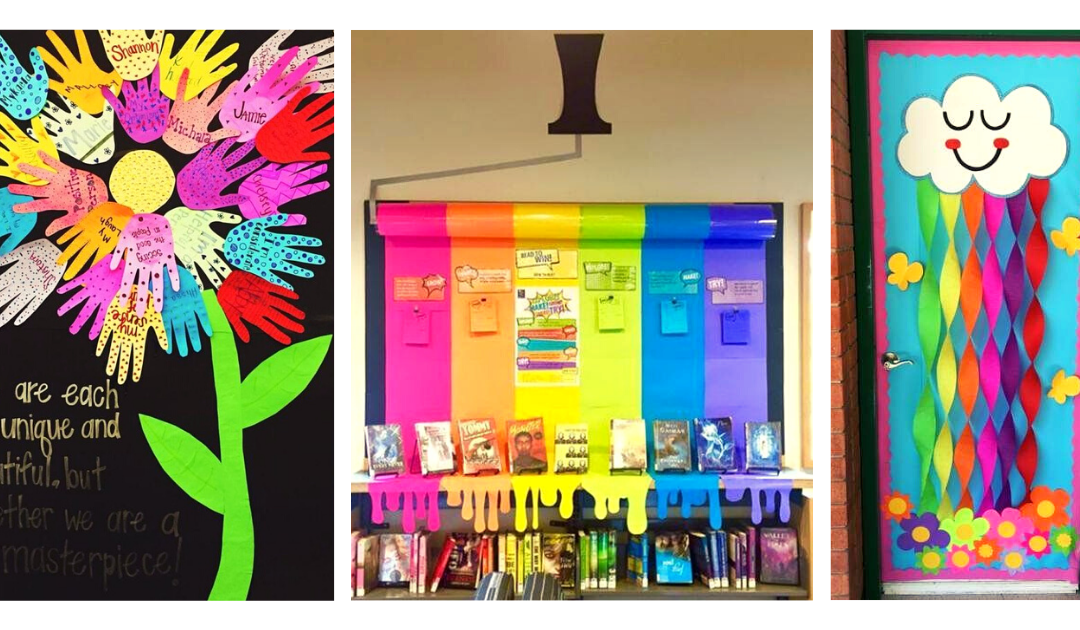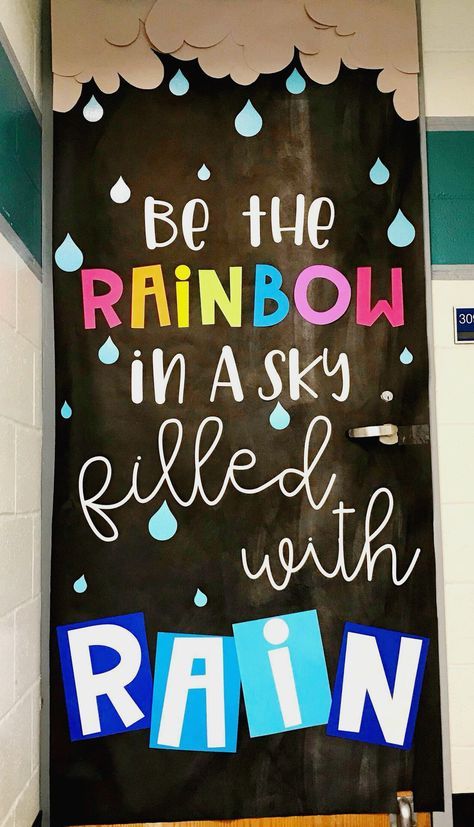
by California Casualty | Educators |
Spring is on the horizon, and that means it’s time to brighten up your classroom!
What better way to ring in the new season than with some bright bulletin boards? Here are some examples to try in your classroom!
1. All The Colors of Me

2. Look Who’s Blooming

3. Soaring Into Spring

4. Raining Rainbows

5. Young Minds Bloom Inside This Room

6. You Are Worth More Than Gold
7. Be the Rainbow

8. Helping People Grow

9. Chillin with my Peeps

10. I’m So Lucky to Have You

11. Reading Helps Your Mind Bloom

12. BEE Amazing

13. Spring is in the Air

14. We’re Buggin’ for Spring

15. A Painted Rainbow

16. We Are Each Unique & Beautiful

17. Be a Rainbow

For more Spring Bulletin Boards and ideas to Brighten Up Your Classroom visit our “Teachers: Brighten Up Your Classroom for Spring!” board on Pinterest!
Don’t forget to give us a follow at California Casualty to stay up to date on every new kindness idea we discover! Scan our Pincode with your Pinterest camera to follow:

This article is furnished by California Casualty, providing auto and home insurance to educators, law enforcement officers, firefighters, and nurses. California Casualty does not own any of the photos in this post, all are sources by to their original owners. Get a quote at 1.866.704.8614 or www.calcas.com.

by California Casualty | Homeowners Insurance Info |
You’ve got a few tools at your disposal for protecting your possessions. First, there’s homeowner’s insurance in the case of theft or loss, but you can also take steps to prevent theft in the first place, by getting a quality home security system.
There are lots of great options out there, and as technology continues to progress, the choices keep expanding. In fact, it can all be a bit overwhelming, so let’s dive into the top considerations you’ll want to look at when choosing a security system – including your first decision point: whether to go with a DIY or a professionally installed system.
DIY vs. Professionally Installed
DIY systems come as packaged kits that you need to install yourself. For most, you’ll be doing the security monitoring, usually via a smartphone app, but some require you to pay for professional monitoring. Professionally installed systems, on the other hand, are installed by a technician, and monitoring is done by the company (trained dispatchers verify triggered alarms and dispatch authorities when needed).
DIY Systems:
Pros
-
-
- Flexibility in tailoring a system to your needs
- Less expensive and usually no monthly fees
Cons
-
-
- Requires you to install the system correctly
- You’re responsible for monitoring (i.e. not missing a smartphone alert!)
Pro-Installed Systems:
Pros
-
-
- System is expertly installed by a trained technician
- 24/7 monitoring by professionals who can dispatch at a moment’s notice
Cons
-
-
- More expensive, with installation and monthly service fees (as well as potential false alarm fees, add-on components, and other fees)
- Usually require multi-year contracts
Popular Systems
Here are some of the most well-known and top-rated systems on the market. In your research, you may find others as well.
DIY Systems:
Pro-Installed Systems:
7 Additional Considerations
As you further hone your choices – be they DIY or pro – here are some other things to take into account.
1. Wireless vs. wired. Systems can be wired or wireless (or sometimes have elements of both). The basic difference is that your control panel and network of sensors are on either a cellular or a landline connection. What you choose will depend on what you need from the system. That said, always make sure to choose a system that includes two-factor authentication for extra security.
2. Pick a system that fits your lifestyle. For instance, is it mainly for when you’re out of town, or also while you’re at home? Do you want it to do smart-home integration, like turning lights off/on, controlling the thermostat, or have sensors for fire, water leak, and glass breaks?
3. Tailor it to your home. For instance, homes with large yards or outdoor areas typically need cameras; condos or apartments can get away with simpler systems.
4. Do your research. No matter if you’re installing your own system or going with a company, learn about all the components available – oftentimes, your system will be a tailored combo of what makes the most sense for keeping your home safe and secure. Systems can include any of the following: control panels, base stations, keypad, locks, contact sensors, motion sensors (interior and exterior), entry sensors, key fobs, glass break sensors, security cameras, door and window sensors, and a variety of different alarms and/or sirens. Most also have signs for your yard or windows to advertise that yours is a secure home.
5. Freedom vs. convenience. If going the DIY route, weigh whether you want the added security of having professional monitoring or if you want to do this yourself. If you’d rather not have that constant responsibility (or stress), that will limit your choices for DIY systems.
6. Conduct due diligence. If you’re leaning towards pro-installed, make sure you get three custom quotes and are clear about how the contracts differ and their terms. Also, take advantage of an in-home consultation if the companies offer it.
7. Check with your local police department. Some municipalities require that anyone running their own security system with professional monitoring obtain a permit. This ensures that their law enforcement and authorities are aware of alarm systems in their jurisdiction.
Choosing the right home security system is a highly personal choice that depends on your lifestyle, budget, home features, and the value of your belongings. Do your research and take your time – but also give yourself a high-five for taking action! Security systems can not only save you money from potential theft, but also prevent the trauma of dealing with a break-in (no one needs that stress right now!). Good luck and also remember to make sure your home insurance is up to date.
This article is furnished by California Casualty, providing auto and home insurance to educators, law enforcement officers, firefighters, and nurses. Get a quote at 1.866.704.8614 or www.calcas.com.

by California Casualty | Health, Safety |
About half of all Americans have been financially affected by the coronavirus. Many have lost jobs or are dealing with reduced hours, and those still working might be anxious about what’s on the horizon. Lean times—even the possibility of them—call for fiscal prudence.
Here are some tips to cut costs and put yourself and your family on better financial footing.
Evergreen Principles
These tips are wise moves in any economy, but especially important right now.
-
- Revise your budget. Depending on your family’s situation, your income and expenses might look very different from just a few months ago. Review with fresh eyes how much money is coming into and out of your household.
- Cut the fat. What are your essential expenses? For most people, it’s rent/mortgage, groceries, loans, and utility payments. For all other expenses, reassess what you really need—and don’t be afraid to make cuts.
- Lower your energy bill. Adjusting your thermostat just a few degrees can translate to dollars saved. Also, check your doors and windows for easy-to-fix gaps that may be leaking air.
- Consolidate your entertainment. Streaming services and subscriptions can add up quickly. Only keep those you use; and turn off “auto-renew.” Cutting your cable can also mean big savings.
- Check cell phone & internet bills. Your plans may have add-ons (extra data, faster speed, etc.) that you’ve forgotten about or don’t need. Ditch those, and then call to change or negotiate your plan—and don’t be afraid to switch providers (many will lower your bill to keep your business).
- Get smart on groceries. Plan meals ahead of time to reduce impulse buys at the store. Make large meals (soups, stews, salads) in big batches to last for days. Vegetarian meals are especially budget-friendly. Also, look at your food waste—and use what you buy.
Made for These Times
Sometimes crises come with opportunities; in the case of coronavirus, there are some new ways to save.
-
- Coronavirus resources. The federal assistance available to those impacted by coronavirus includes resources for unemployment, healthcare, loans, stimulus checks, and business aid. Check the site to see if you’re eligible.
- Free subscriptions. Many digital platforms are offering free subscriptions right now. From streaming services and educational programs to online workouts, you can find a lot just by doing a web search.
- Low refinance rates. The Federal Reserve’s recent slashing of the interest rate translates to very low rates on loans. If you were considering refinancing your mortgage or another large loan, this might be a great time.
- Lower debt interest. Federal student loan interest (along with principal) has been suspended until September 30, 2020. Check with your other creditors to see if they will work with you to lower your interest rate or temporarily suspend it.
- Eviction, rent, and mortgage protection. Due to widespread hardship, there are assistance programs available for rent and mortgage payments, as well as protection against eviction. Check your state’s programs and the Federal website.
- Summer Skip option. Educators who are California Casualty policyholders can opt to take a break from premium payments during the summer months.
If you’re able to, pad your healthcare and emergency savings as much as possible. If you’re expecting a tax refund (tax day has been extended to July 15), try to stash that in savings.
Hopefully, the lean times will be temporary, but you’ll never regret saving money where you could.
This article is furnished by California Casualty, providing auto and home insurance to educators, law enforcement officers, firefighters, and nurses. Get a quote at 1.866.704.8614 or www.calcas.com.

by California Casualty | Safety |
Our world has changed seemingly overnight. As we deal with the immediate crisis—and learn behaviors that ensure the safety and well-being of ourselves and others—we all have an opportunity to make our world a kinder and more generous one.
Here are 8 ways to be a good neighbor during trying times.
Stay safe, stay home
Across the country, various forms of shelter-in-place and social distancing orders have gone into effect. Stay up to date on your city’s instructions and follow the orders and advice of local officials. By slowing and limiting the spread of infection, we can “flatten the curve”—protecting vulnerable community members and preventing local hospitals and emergency services from overwhelm.
Check-in
For the elderly, immunocompromised or otherwise vulnerable, these are especially scary times. Reach out to those neighbors and friends (on the phone, email, through a closed door) and see if there’s anything you can do for them. A grocery run, food pickup or dog walk could make a huge difference. Let them know you’re there for them. If you yourself are in the vulnerable cohort, make it easy for others to know how they can help—there are plenty who want to help but don’t know how.
Donate blood
In the midst of coronavirus anxiety, blood drives have been canceled and donations have dropped. However, maintaining our nation’s blood supply is still critical: Every 2 seconds, a patient needs a blood transfusion. If you’re healthy, consider giving blood. Donation centers are skilled in infection control practices and adhere to strict safety procedures.
Do a virtual food drive
You can deliver needed groceries to families and community members right from your computer. Check the websites of your local food banks, city or city health departments or non-profits that focus on food insecurity. You can sign up as an individual or as a group. For the latter, get creative and launch a drive with friends, family, colleagues or neighbors.
Volunteer
Check with local non-profits, charities or your city for volunteer needs. Many neighborhoods are also forming their own emergency response teams. Volunteers can sign up for a range of activities or projects. If you have the gift of health and security, volunteering is one of the most rewarding ways to pay it forward.
Shop local
Local businesses are hurting, and some may not recover. Patronage right now is more crucial than ever. Place orders online; buy gift cards; keep up your membership. Many restaurants are staying afloat by offering take-out and delivery—if you can afford it, mix up your in-home creations with local cuisine. And if you can be generous in tipping your delivery drivers, you’ll be helping them through a rough time.
Donate
Public health crises spotlight the gaps in our communities and this crisis is no different. Many hospitals are in need of gloves, goggles, N95 masks, disinfectant wipes, hand sanitizer, gowns, and other PPE. Look through your closets and garage and see if you’ve got extras (new and unused) you can donate to local hospitals. Also check in with your favorite charities, causes or non-profits and see how you can help.
Spread kindness
These are stressful times, and a little kindness goes a long way. For those workers on the front lines (who themselves are at increased risk), receiving some patience, kindness, and compassion from customers will buoy their spirits. Be generous where you can. Remember too, that just as with the oxygen mask in the airplane, you can only take care of others after taking care of yourself. So, find ways to make self-care and mental health a priority.
This article is furnished by California Casualty, providing auto and home insurance to educators, law enforcement officers, firefighters, and nurses. Get a quote at 1.866.704.8614 or www.calcas.com.
by California Casualty | Educators |
Collecting and analyzing student data doesn’t have to be burdensome. Using the right data-tracking tools, teachers can efficiently use student data to guide instruction. Check out some different ways you can easily track student data.
Google Forms – If you are into technology as a means for data collection, Google Forms may be beneficial to you. This survey tool can gather student data for you in a Google spreadsheet. Try these tips on using Google Forms for formative assessment checklists.
Data Folders for Students – I ask my students to graph their own progress on weekly assessments and quizzes. Tracking their own data gives students ownership over their accomplishments or struggles, and, in many cases, helps students to improve. I use data folders similar to this free one from Bunting, Books, and Bright Ideas. I provide folders and keep them in an easily accessible basket. These are also great to show parents at conference time!
Classroom Data Walls – Displaying student data creatively on a bulletin board is a debatable method of tracking student data. However, WeAreTeachers says “the key to these boards is that they are limited to a single skill set of foundational skills that mostly require memorization. Giving students permission to monitor their own progress makes it feel more like a game than a report card.” To make your data wall more confidential, use student numbers in lieu of student names. I have found these data walls to be motivating for many students.
Teacher Data Binder – Keeping all of your student data in one, organized, central location keeps you up-to-date on student progress. When you need to access student information quickly, a data binder comes in handy. This free, printable data binder from The Curriculum Corner contains everything you need to make your own. Or, try these free data tracking sheets from Brandy Shoemaker.
Data Clipboards – Clipboards are especially useful for small groups. Color code your clipboards or mark them in a way that makes them easy to identify when you need to grab one quickly. Hang them on the wall near where your groups meet. Students can track data themselves using the clipboards or the teacher can use them as an assessment-tracking tool.
This article is furnished by California Casualty, providing auto and home insurance to educators, law enforcement officers, firefighters, and nurses. Get a quote at 1.866.704.8614 or www.calcas.com.






















